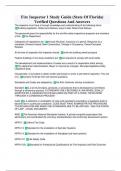Fire Inspector 1 Study Guide (State Of Florida ) Verified Questions And Answers The inspector must have a through knowledge and understanding of the following items: Enabling legislation, State/Local Statues, ways to alter State/Local Statues The personnel given the responsibility for fire and life safety inspections programs are members of the: Fire Department Categories of Inspections are: Annual (Routine), Issuance of a permit, Response to a complaint, Eminent hazard, New Construction, Change in Occupancy, Owner/Occupant Request At the time of inspection the inspector should: invite the building owner/occupant Federal buildings in the local jurisdiction are not required to comply with local codes The development and implementation of codes are a result of a cooperative effort among: Fire department administration, Mayor or city/county manager, Municipal legislative body, Legislative body Occasionally, it is prudent to obtain written permission to enter a site before inspection. The use of a: Consent -To-Enter form will remove questions Standards and Codes are adopted by: the AHJ (Authority Having Jurisdiction) Standard is a set of principles, protocols, or procedures that is developed by committees through a consensus process. A STANDARD ONLY BECOMES A LAW WHEN LEGALLY ADOPTED BY A JURISDICTION OR INCLUDED AS PART OF A CODE. "DEVELOPED THROUGH A CONSENSUS PROCESS" Code is a collection or compilation of rules and regulations enacted by a legislative body to become law in a particular jurisdiction. CODE MUST HAVE ADMINISTRATIVE PROVISIONS TO EXPLAIN HOW AND WHEN THE STANDARDS ARE TO BE APPLIED. "HAS THE FORCE OF LAW" --LEGAL DOCUMENT -- ANSI The American National Standards Institute. A private nonprofit organization that administers and coordinated the voluntary standardization and conformity assessment system. NFPA 1 Uniform Fire Code NFPA 13 Standard for the installation of Sprinkler Systems NFPA 14 Standard for the installation of Standpipe and hose systems NFPA 101 Life Safety Code NFPA 1031 Standard for Professional Qualifications for Fire Inspector and Plan Examiner Smoke Damper Device installed in air ducts that penetrate a vertical or horizontal assemble such as a wall, floor, or ceiling. Designed to restrict the movement of smoke between compartments. Board of Appeals Has authority to interrupt fire code, consists of 3 -7 members who have experience in fire prevention or building construction. Variance A one time modification Primary duty of a fire inspector to ensure the life safety of both citizens and fire and emergency responders. Oxidation is a chemical reaction involving the combination of oxygen and other materials. Fire Triangle HEAT, OXYGEN, FUEL Fire Tetrahedron FUEL, OXYGEN, HEAT, CHEMICAL REACTION Air consists of 21 Percent Oxygen Potential Energy energy possessed by an object that may be released Chemical Heat Energy Energy that is released when two or more chemicals combine and react with one and another. Chemical heat energy is the most common source of heat in combustion reactions. Mechanical Heat Energy Form of energy generated by friction or compression. Conduction Transfer of heat within an object or to another object by direct contact. Convection Transfer of heat energy from a fluid to a solid Radiation Transmission of energy as an electromagnetic wave, light waves, radio waves... Class A Fires Involve ordinary, solid, combustible materials such as wood, cloth, paper, rubber, and many plastics Class B Fires Involve flammable and combustible liquids and gasses such as gasoline, oil, lacquer... Class C Fires Involve energized electrical equipment Class D Fires Involve combustible metals such as aluminum Class K Fires Involve oils and greases normally found in commercial kitchens Fire Development Incipient Stage, , Growth Stage, Fully Developed, and Decay Thermal Layering Tendency of gasses to separate into layers according to temperature. Rollover Describes a condition where the unburned fire gases accumulated at the top of a compartment ignite and flames propagate through the hot -gas layer Fully Developed Stage Occurs when all combustible materials in the compartment are burning. Factors that affect Fire Fuel, Location, Compartment Volume, Ventilation, Ambient Conditions such as wind, humidity.. Bearing Wall Wall that supports itself and the weight of the roof Type 1 Construction Non or Limited Combustible materials. Highest Safety Levels. Type 2 Construction Low Fire Risk, Materials won't contribute to the spread. Type 3 Construction Used in schools, churches, mercantile. Exterior walls are non -
combustible. Type 4 Construction Heavy Timber, Large Dimensioned lumber. Type 5 Construction Commonly known as wood frame Assembly Occupancies 50 or more people, Churches, Arenas, Theaters.. Business Occupancies Large number of occupants Educational Occupancies Pre-School through 12th grade. High Loads, Multiple Uses.. Factory/Industrial Occupancies Factory, subdivided due to use Institutional Occupancies People with physical limitations, penal or corrections institutions. Health Care and Ambulatory Care Occupancies 4 or more people who can not evacuate on their own Residential Board and Care Occupancies 4 or more unrelated to the owners. Locations where lodging, boarding, and personal care are provided. Mercantile Occupancies Any building used to display or sell merchandise, potential for high loss of life, large quantities of combustibles Residential Occupancies Provide sleeping accommodations under conditions other than health care. Hotel Occupancies Sleeping rooms for transients




